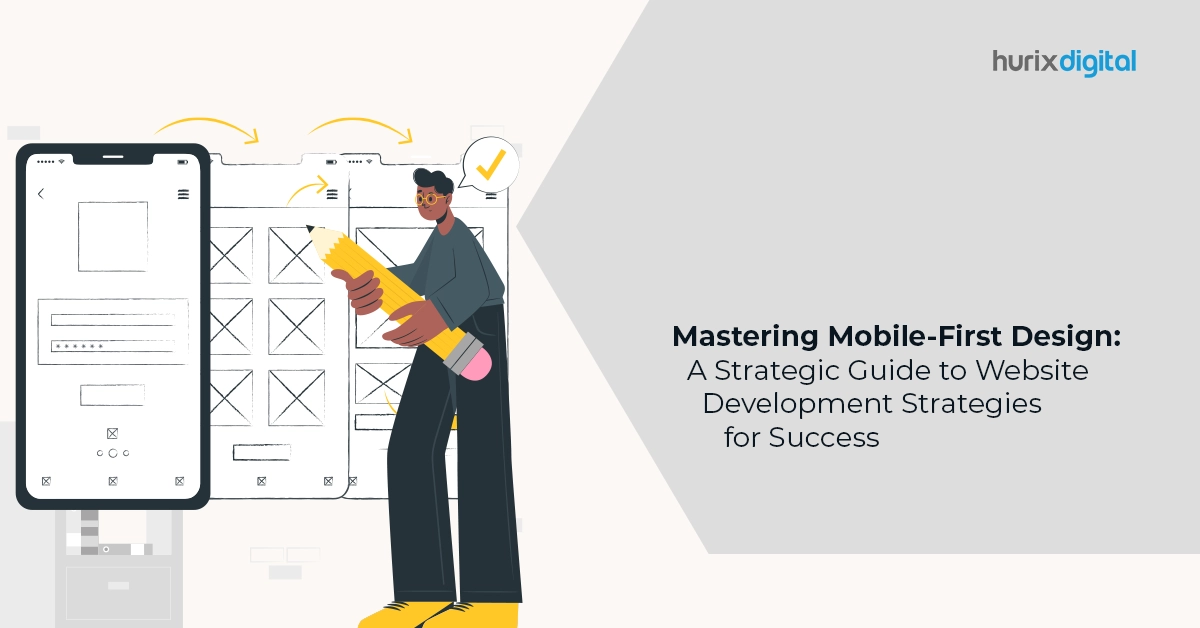
Mastering Mobile-First Design: A Strategic Guide to Website Development Strategies for Success
Summarize with:
The digital landscape has undergone a huge shift in recent years. Global mobile user figures are expected to climb to 7.49 billion by 2025. This dominance of mobile devices has revolutionized web interactions, prompting businesses to prioritize mobile-first design strategically.
By recognizing smartphones and tablets as primary gateways to the online world, businesses can ensure intuitive, fast-loading, and visually appealing websites. This shift towards mobile optimization fosters seamless user experiences, driving higher engagement and conversion rates compared to traditional desktop-centric approaches.
Table of Contents:
- Mobile-First Design: Explained
- 7 Best Practices for Optimal User Experience
- Emphasize Content for Maximum Impact
- Prioritize Simplicity and Intuitive Navigation
- Maximize Speed for a Seamless Mobile Experience
- Adopt Continuous Improvement through User Testing
- Write Compelling Calls to Action (CTAs)
- Focus on Mobile SEO and Google Indexing
- Responsive Design for a Seamless User Experience
- Wrapping Up
Mobile First Design: Explained
There is no denying that mobile devices are the dominant force in the modern digital world.
In light of this paradigm shift, a fundamental adjustment to the idea of web design is required. Previously, desktop users were the main target audience for designers, and smaller screen sizes were accommodated. The mobile-first development methodology reverses this reasoning.
The goal of mobile-first design is to create the best possible user experience on tablets and smartphones. It means carefully ranking features and information to provide a simple and easy-to-use interface on even the smallest screen sizes.
Websites are designed with the user’s experience in mind, with an emphasis on usability, clear calls to action, and fast loading times. This fundamental mobile experience is then used to gradually add features and functionalities for bigger devices, such as tablets and desktop computers.
In essence, mobile-first design is a user-centric approach to developing a web strategy that acknowledges the realities of the modern digital landscape.
Also Read: The Ultimate Guide to WCAG Compliance for the Website Developers
7 Best Practices for Optimal User Experience
While website development presents inherent challenges, a strategic approach guided by established best practices enables teams to create exceptional user experiences.
Mentioned below are crucial mobile-first design principles, equipping you with the necessary knowledge to integrate this approach into your website creation process:
1. Emphasize Content for Maximum Impact
Mobile-first design demands an unwavering focus on content upfront. Limited screen size necessitates a laser focus on what truly matters to your users.
Extensive content hierarchies should be replaced with a streamlined approach, with designers assigning priority to the inclusion of only the most essential elements. The focus in mobile-first development should be on crafting concise, high-quality content that prioritizes the user’s needs. Identify the core information your consumers seek and ensure it is prominent and accessible.
This optimized approach promotes a user-centric experience, maximizing engagement and driving conversions on the most essential platform: mobile.
2. Prioritize Simplicity and Intuitive Navigation
The mobile-first design emphasizes clean layouts and effortless user journeys. Cluttered interfaces, excessive text, and convoluted navigation are a big no. Instead, adopt clean typography, ample white space, and intuitive gestures to guide users through your site architecture with minimal friction.
- Streamline Content: Focus on the most essential information, eliminating extraneous elements that detract from the core message.
- Declutter the Design: Resist the urge to cram too much onto the screen. Utilize whitespace strategically to enhance readability and focus.
- Minimize Distractions: Users are not fans of intrusive pop-ups or ads that block their view. Deliver the information they seek quickly and efficiently by omitting obtrusive pop-ups and advertisements that disrupt the user experience.
- Clear Navigation Structure: Employ a simple and well-organized navigation system that is easy to understand and navigate, even on a small screen.
- Intuitive Icons and Labels: Utilize universally recognized icons and clear labels for navigation elements to foster user comprehension.
- Optimize for Touch Screens: Design navigation elements that are large enough and spaced appropriately for easy tapping on a mobile device.
3. Maximize Speed for a Seamless Mobile Experience
Mobile users have limited patience with website loading times. Nearly 40% of online users abandon websites with load times exceeding 3 seconds. For optimal user engagement, make website speed performance a top priority.
- Minimize HTTP Requests: Streamline the number of resources your website needs to load, reducing overall download time.
- Leverage Caching: Utilize browser caching to store frequently accessed elements locally, minimizing server requests on subsequent visits.
- Optimize Images: Compress images effectively to reduce file size without sacrificing quality to minimize data usage and improve loading speed.
- Content Delivery Networks (CDNs): Consider using a CDN to deliver website assets from geographically distributed servers, reducing latency for geographically diverse users.
4. Adopt Continuous Improvement through User Testing
Mobile-first design is an iterative process. Continuously gathering user feedback and refining your mobile website based on real-world data can cultivate a functional experience that enhances user engagement and drives conversions. To ensure your website delivers an optimal user experience, schedule ongoing user testing.
- A/B Testing: Conduct controlled experiments to compare multiple layouts, design elements, and content strategies. This data-driven approach helps identify what resonates best with your mobile audiences.
- Real-World Testing: Test your website on numerous devices, screen sizes, and operating systems to ensure a seamless experience across all platforms users employ.
5. Write Compelling Calls to Action (CTAs)
Mobile-first design demands a strategic approach to calls to action (CTAs). Tiny text links are often missed on small screens. Instead, leverage visual design to create prominent and action-oriented CTAs. Designing clear, appealing, and action-oriented CTAs guides mobile users toward conversion, driving them down the sales funnel and achieving your business goals.
- Visually Appealing: Combine clean lines, vibrant colors, and strong typography to make your CTAs stand out.
- Action-Oriented Language: Employ verbs that inspire users to take the next step, such as “Download,” “Learn More,” or “Shop Now.” Action verbs in CTAs can boost conversion rates by 122%.
- Tap-Friendly Size: Ensure your CTAs are large enough for easy tapping on a touchscreen.
- Tap-to-Call Functionality: Consider incorporating “Tap-to-Call” CTAs that allow users to connect with your business directly from their mobile device, streamlining the conversion process.
6. Focus on Mobile SEO and Google Indexing
Google Indexing is the process by which Google’s web crawlers discover and catalog websites. If your mobile-first website is not indexed, it essentially remains invisible to potential users searching for your products or services.
- Mobile-First Indexing: Google gives your website’s mobile version top priority when it comes to indexing and ranking. A website that is mobile-friendly, has a simple layout, loads quickly, and prioritizes the user experience is more likely to rank well in search results.
- Enhanced Visibility: Effective Mobile SEO practices, like optimizing for local and voice search, ensure your website ranks higher in relevant mobile search results. It increases the probability of users discovering your business when they search online.
- Targeted Audience Reach: Implementing development SEO strategies emphasizing mobile experience, positioning your website to attract a wider audience actively searching via smartphones and tablets.
Neglecting website development SEO and Google Indexing relegate your mobile-first website to the digital shadows.
7. Responsive Design for a Seamless User Experience
The overarching objective is to facilitate a frictionless user experience across devices characterized by varying physical attributes, including screen size and resolution. It involves optimizing website layout, content (text and media), and performance to function optimally on all platforms, regardless of the device used to access it.
Fundamentals of RWD for mobile-first success:
- Fluid Layouts: Utilize flexible grids that adjust content placement based on screen size, eliminating the need for horizontal scrolling on mobile devices.
- Responsive Images: Implement images that scale proportionally to the available screen real estate, ensuring optimal image clarity across all platforms.
- Media Queries: Leverage CSS media queries to tailor styles and layouts for specific screen sizes and orientations, creating a visually cohesive experience.
Also Read: 10 Tips to Make Your Website Accessible to Everyone
Wrapping Up
With the digital landscape shifting towards mobile dominance, a mobile-first approach is no longer a peripheral consideration but rather a strategic necessity. Neglecting mobile optimization risks alienating a significant portion of the online audience, jeopardizing a company’s ability to compete and flourish in the evolving digital world.
Prioritizing the mobile user experience is a prudent website development imperative for businesses seeking to build stronger customer relationships, drive user engagement, and achieve conversion objectives. A website that fails to shine on smartphones simply cannot compete in this mobile-centric world.
Hurix Digital, an award-winning mobile-first development platform, accelerates your mobile website’s journey from concept to reality.
Leverage our team’s experience to design a website optimized for the mobile revolution. Hurix Digital provides comprehensive solutions encompassing design, rigorous testing, and strategic post-launch digital marketing initiatives.
Contact us now!
Summarize with:

Vice President & SBU Head –
Delivery at Hurix Technology, based in Mumbai. With extensive experience leading delivery and technology teams, he excels at scaling operations, optimizing workflows, and ensuring top-tier service quality. Ravi drives cross-functional collaboration to deliver robust digital learning solutions and client satisfaction
 A Space for Thoughtful
A Space for Thoughtful 



